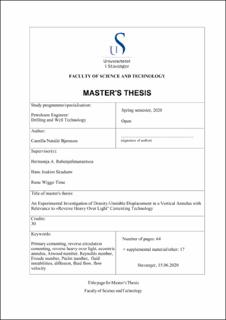| dc.contributor.author | Bjoernsen, Camilla Natalie | |
| dc.date.accessioned | 2020-10-19T13:33:25Z | |
| dc.date.available | 2020-10-19T13:33:25Z | |
| dc.date.issued | 2020-07-15 | |
| dc.identifier.uri | https://hdl.handle.net/11250/2683710 | |
| dc.description | Master's thesis in Petroleum engineering | en_US |
| dc.description.abstract | Primary cementing of casing is considered a critical and complex well operation. During the operating, the drilling fluid is displaced by pumping a fluid train of washer, spacer, and cement slurry into the well. The aim is to fully displace the drilling fluid without contaminating the cement slurry or leaving residual drilling fluid behind. The hardened cement acts as a well barrier and should provide structural support for the casing, meaning that an effective and complete displacement is crucial for the whole life of the well. Studies show that reverse circulation method used for cementing has some advantages. The method is for example used when cementing over weak formation where a lower circulation pressure is needed. When using reverse circulation method, the fluid train is pumped directly into annulus placing the heavy fluid over the lighter drilling fluid. No experimental research of such density-unstable displacement in annulus has been executed so far. The effect of density differences, flow and eccentricity on the displacement process is yet unknown. This knowledge gap needs to be addressed in order to enable more reliable primary reverse cementing operations, especially in offshore wells.
We present an experimental study of density-unstable displacement of Newtonian fluid in an annular space. The focus is on the effect of density difference and flow rate. In an experimental setup, heavy displacement fluid is placed above a lighter displaced fluid inside a pipe using a valve separating the two fluids. The density difference is achieved by using NaCl as weighting agent in the heavy fluid, and the flow rate is adjusted by opening an outlet valve. In several runs, At of 0.0035 and 0.01, and velocities of 0, 10, and 20 mm/s are combined. For all experimental runs, mixing of fluid, transverse and backflow is seen. The level of such instabilities and counter-current flow is found to be dependent on both density difference and flow velocity. For the displacement of zero velocity, an increase of At seems to results in a more effective displacement with less mixing of the two fluids. This effect is also seen in displacement with velocity = 10 mm/s, but the effect is less prominent. For velocity = 20 mm/s, the change in density difference has no or little effect and the flow velocity becomes dominant. With an increase in velocity, the level of transverse flow and backflow seems to decrease. As the velocity increases the downward flow becomes more dominant and interrupts the rising of light fluid. This results in a more efficient displacement where more of the displaced fluid is pushed downwards in the pipe. | en_US |
| dc.language.iso | eng | en_US |
| dc.publisher | University of Stavanger, Norway | en_US |
| dc.relation.ispartofseries | Masteroppgave/UIS-TN-IEP/2020; | |
| dc.subject | petroleumsteknologi | en_US |
| dc.subject | petroleum engineering | en_US |
| dc.subject | boreteknologi | en_US |
| dc.subject | fluid instabilities | en_US |
| dc.subject | eccentric annulus | en_US |
| dc.subject | fluid flow | en_US |
| dc.subject | flow velocity | en_US |
| dc.subject | diffusion | en_US |
| dc.subject | péclet number | en_US |
| dc.subject | froude number | en_US |
| dc.subject | reynolds number | en_US |
| dc.subject | atwood number | en_US |
| dc.subject | reverse heavy over light | en_US |
| dc.subject | primary cementing | en_US |
| dc.subject | reverse circulation cementing | en_US |
| dc.title | An Experimental Investigation of Density-Unstable Displacement in a Vertical Annulus with Relevance to «Reverse Heavy Over Light" Cementing Technology | en_US |
| dc.type | Master thesis | en_US |
| dc.subject.nsi | VDP::Teknologi: 500::Berg‑ og petroleumsfag: 510::Petroleumsteknologi: 512 | en_US |
